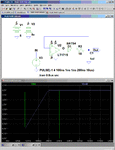Bakez
Member level 1
Hello
I have a peak detector that detects the peak voltage drop over a resistor that charges a capacitor. Its just an opamp and a diode+ capacitor as you can see, and the capacitor is discharged using the control of the actual gate voltage
However I need to remove the temperature coefficient of the diode, when I calibrate this circuit the change in the voltage drop over the diode ruins my measurement
How can I do this? I read that most peak detector circuits that remove the diode voltage drop mean the opamp goes into saturation and is therefore always slow. I can't have this as I'm detecting peaks that occur about 200nS into a window that only lasts about 800nS.
You can see in the pics I attach
Although with these opamps in the LTSpice simulation, the saturation doesnt appear to cause a problem, I dont think the additional heat generated from always driving the opamp to the rails is acceptable as this circuit will be running 24/7.
I either need to compensate for the temperature or a way to remove the diode voltage drop without driving the opamp into saturation
Does anyone have any ideas?
I have a peak detector that detects the peak voltage drop over a resistor that charges a capacitor. Its just an opamp and a diode+ capacitor as you can see, and the capacitor is discharged using the control of the actual gate voltage
However I need to remove the temperature coefficient of the diode, when I calibrate this circuit the change in the voltage drop over the diode ruins my measurement
How can I do this? I read that most peak detector circuits that remove the diode voltage drop mean the opamp goes into saturation and is therefore always slow. I can't have this as I'm detecting peaks that occur about 200nS into a window that only lasts about 800nS.
You can see in the pics I attach
Although with these opamps in the LTSpice simulation, the saturation doesnt appear to cause a problem, I dont think the additional heat generated from always driving the opamp to the rails is acceptable as this circuit will be running 24/7.
I either need to compensate for the temperature or a way to remove the diode voltage drop without driving the opamp into saturation
Does anyone have any ideas?



